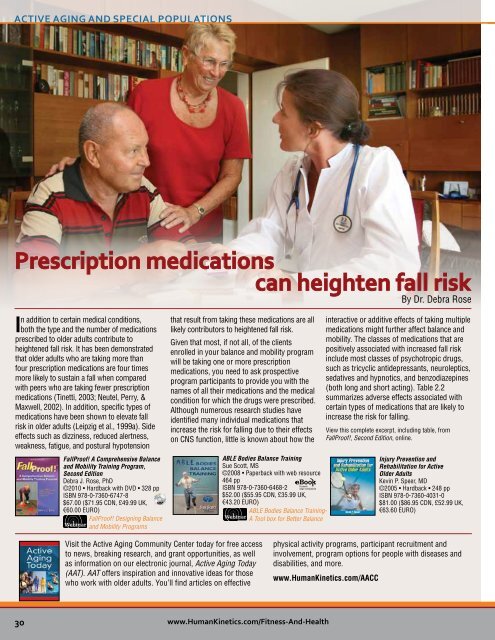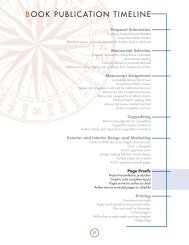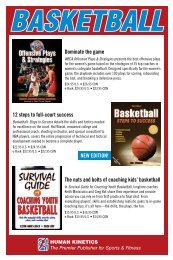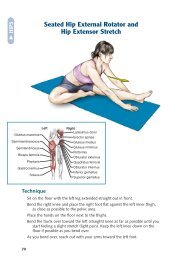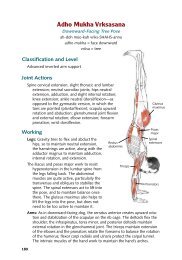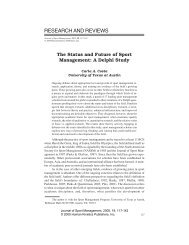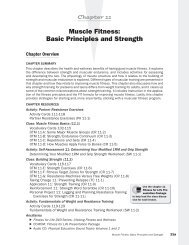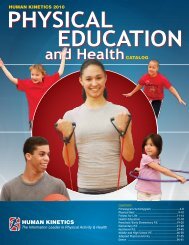PROTEIN PROTEIN - Human Kinetics
PROTEIN PROTEIN - Human Kinetics
PROTEIN PROTEIN - Human Kinetics
You also want an ePaper? Increase the reach of your titles
YUMPU automatically turns print PDFs into web optimized ePapers that Google loves.
active aging and special populations<br />
Prescription medications<br />
can heighten fall risk<br />
In addition to certain medical conditions,<br />
both the type and the number of medications<br />
prescribed to older adults contribute to<br />
heightened fall risk. It has been demonstrated<br />
that older adults who are taking more than<br />
four prescription medications are four times<br />
more likely to sustain a fall when compared<br />
with peers who are taking fewer prescription<br />
medications (Tinetti, 2003; Neutel, Perry, &<br />
Maxwell, 2002). In addition, specific types of<br />
medications have been shown to elevate fall<br />
risk in older adults (Leipzig et al., 1999a). Side<br />
effects such as dizziness, reduced alertness,<br />
weakness, fatigue, and postural hypotension<br />
FallProof! A Comprehensive Balance<br />
and Mobility Training Program,<br />
Second Edition<br />
Debra J. Rose, PhD<br />
©2010 • Hardback with DVD • 328 pp<br />
ISBN 978-0-7360-6747-8<br />
$67.00 ($71.95 CDN, £49.99 UK,<br />
€60.00 EURO)<br />
FallProof! Designing Balance<br />
and Mobility Programs<br />
that result from taking these medications are all<br />
likely contributors to heightened fall risk.<br />
Given that most, if not all, of the clients<br />
enrolled in your balance and mobility program<br />
will be taking one or more prescription<br />
medications, you need to ask prospective<br />
program participants to provide you with the<br />
names of all their medications and the medical<br />
condition for which the drugs were prescribed.<br />
Although numerous research studies have<br />
identified many individual medications that<br />
increase the risk for falling due to their effects<br />
on CNS function, little is known about how the<br />
ABLE Bodies Balance Training<br />
Sue Scott, MS<br />
©2008 • Paperback with web resource<br />
464 pp<br />
ISBN 978-0-7360-6468-2<br />
$52.00 ($55.95 CDN, £35.99 UK,<br />
€43.20 EURO)<br />
ABLE Bodies Balance Training-<br />
A Tool box for Better Balance<br />
By Dr. Debra Rose<br />
interactive or additive effects of taking multiple<br />
medications might further affect balance and<br />
mobility. The classes of medications that are<br />
positively associated with increased fall risk<br />
include most classes of psychotropic drugs,<br />
such as tricyclic antidepressants, neuroleptics,<br />
sedatives and hypnotics, and benzodiazepines<br />
(both long and short acting). Table 2.2<br />
summarizes adverse effects associated with<br />
certain types of medications that are likely to<br />
increase the risk for falling.<br />
View this complete excerpt, including table, from<br />
FallProof!, Second Edition, online.<br />
Injury Prevention and<br />
Rehabilitation for Active<br />
Older Adults<br />
Kevin P. Speer, MD<br />
©2005 • Hardback • 248 pp<br />
ISBN 978-0-7360-4031-0<br />
$81.00 ($86.95 CDN, £52.99 UK,<br />
€63.60 EURO)<br />
Visit the Active Aging Community Center today for free access<br />
to news, breaking research, and grant opportunities, as well<br />
as information on our electronic journal, Active Aging Today<br />
(AAT). AAT offers inspiration and innovative ideas for those<br />
who work with older adults. You’ll find articles on effective<br />
physical activity programs, participant recruitment and<br />
involvement, program options for people with diseases and<br />
disabilities, and more.<br />
www.<strong>Human</strong><strong>Kinetics</strong>.com/AACC<br />
30<br />
www.<strong>Human</strong><strong>Kinetics</strong>.com/Fitness-And-Health


